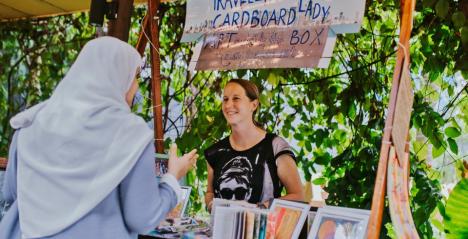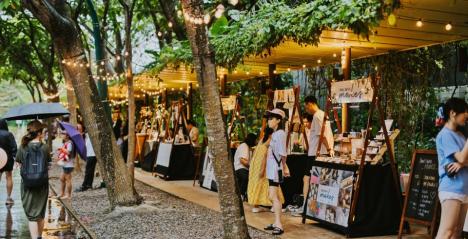From its first iteration in 2013, Free Jazz has pushed boundaries and expanded upon pressing concerns of our times. Free Jazz IV. Geomancers continues this approach, featuring artworks ranging from virtual reality to video, performance, and sound as an
exercise in planetary awareness.
The exhibition presents significant artistic practices from across the globe that are deeply invested in creating an environmental consciousness and that share an understanding of the world as a vulnerable, yet resilient, mesh of coexistences, correlations, and co-creations. As with geomancy, the curators believe that these artworks can help us to read the signs that our planet is trying to send us and that they can inspire a stronger commitment to create a sustainable future for life on Earth.
Alongside scientists, environmental activists, enlightened policymakers and civil society members, contemporary artists are increasingly concerned with future prospects of ecological collapse and planetary survival. They address these issues through the language of art, creating images, sounds, narratives, and experiences that allow us to establish affective and cognitive connections with the environment and partake in the planetary intelligence of the Earth. Stemming from NTU CCA Singapore’s ongoing engagement with the overarching subject of Climates. Habitats. Environments., Free Jazz IV. Geomancers brings together a selection of creative practitioners who are distinctly alert to these urgencies.
Conceived for Singapore Art Week 2022, this programme consists of a film screening series, a virtual reality installation, a performance, and a sound installation. Some of the featured artworks zero in on signs of earthly demise, others indicate pathways of resilience and strategies for regeneration. All the works result from long-term research and extensive fieldwork and, when presented together, they engender a kaleidoscopic overview of the multitudinous forms of ecological entanglements.

With a shared focus on the phenomenology of endangered environments, the works of Katie Paterson and Daniel Steegmann Mangrané explore different kinds of sensorial engagements with forest ecologies. Based on a partly scientific, partly speculative investigation, Paterson’s performance To Burn, Forest, Fire condenses spatial distance and abysmal temporalities into an ephemeral olfactory experience that allows participants to encounter the scent of two forests, the first and the last forest on Earth.

Located off-site on the Green Roof at Marina Barrage is Jana Winderen’s sound installation Listening Through the Dead Zones. Consisting of field recordings of underwater soundscapes in different seas around the world, the work awakens our sonic imagination to the rapidly expanding phenomenon of ‘dead zones’, areas where aquatic life is doomed by insufficient oxygen concentrations caused by human activity.

Taking place in NTU CCA Singapore’s newly launched Screening Room, this selection of video works will be on view in what was formerly one of the Centre’s Residencies Studios, now converted into a cinematic space.
Ecological disruptions within the largely urbanised context of Singapore surface in earth, land, sky and sea as palimpsest, a video collaboratively created by Zarina Muhammad and Zachary Chan that performs a meandering meditation on the loss, but also the resilience, of ecological and spiritual realities confronted with the sprawl of modern infrastructures.

A disturbance of natural patterns is also captured in And A Great Sign Appeared, a short video made with cell phone footage by Robert Zhao Renhui. Imbued with a sense of foreboding, it documents an unusual airborne event that punctuated the skyline of the sea-locked metropolis for a few days. With Inventing Miracle: The Rice to Power, Chu Hao Pei explores his interest in seed sovereignty by unpacking the relations between rice and politics in Southeast Asia during the 1960s.

The brunt of sea level rise and profit-driven development on small island communities in the Philippines is captured by Martha Atienza in Panangatan, an experimental video devoid of narrative and sound which lays bare the state of dilapidation and disrepair fishermen villages are struggling with due to anthropogenic changes.
Premised on relational connections and inclusive kinships with the other-than-human, indigenous perspectives can significantly contribute to re-orientate our understanding of the world in non-anthropocentric directions. The practice of the South Korean eco-feminist collective Rice Brewing Sisters Club seeks to activate collective processes to explore new social relations and environmental practices.

Combining the performative, the playful, and the poetic, their video Mountain Storytellers, Storytelling Mountains: A Tale Theatre results from a process of co-creation whereby residents of a South Korean rural community and other non-human actors enact local folkloric tales that suggest alternative forms of interspecies co-existence.
In the experimental documentary The Teaching of the Hands, Carolina Caycedo and David de Rozas also summon up the cosmological consciousness of indigenous people—here voiced by Juan Mancias, the Chairman of the Carrizo/Comecrudo Tribe of Texas—to counter a colonial approach to the land based on surveying techniques and extractivist plans.

The extent to which different ecologies of knowledge produced by ethnic minorities may be threatened by economic development is also the subject of Liu Chuang’s Can Sound be Currency?, a video that investigates the entanglement between humans, the environment, and the supernatural in a mountainous area of the Sichuan province in China.

Mind-bending narratives are deployed in the video works of Pedro Neves Marques and Ursula Biemann to spur the viewer’s imagination beyond conventional understandings of the world around us. Revolving around the relations between human and non-human lifeforms, the works feature respectively an Android and an Aquanaut as main characters.
Both create science-fictional frameworks wherein viewers find themselves either navigating the moral complexity triggered by the blurring borders between the natural and the artificial (Neves Marques) or exploring the sonic and semiotic intricacy of underwater soundscapes (Biemann).
Admission to all programmes and events is free unless otherwise stated.
You May Also Like
Tenth Singapore Art Week Celebrates Legacies and New Frontiers
a. Blk 6 Lock Road, Gillman Barracks Singapore, Singapore 108934
w. ntu.ccasingapore.org/news/free-jazz-iv-geomancers











